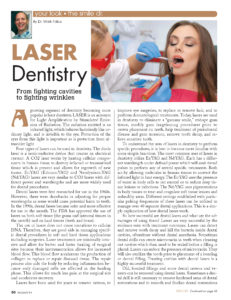From fighting cavities to fighting wrinkles
A growing segment of dentistry becoming more popular is laser dentistry. LASER is an acronym for Light Amplification by Stimulated Emission of Radiation. The radiation emitted is an infrared light, which behaves harmlessly like ordinary light, and is invisible to the eye. Protection of the eyes from this light is important as is protection from ultraviolet light.
Four types of lasers can be used in dentistry. The diode laser is a semiconductor device that creates an electrical current. A CO2 laser works by heating cellular components in human tissue to destroy infected or traumatized tissue which is present and allows for regrowth of new tissue. Er:YAG (Erbium:YAG) and Neodynium:YAG (Nd:YAG) lasers are very similar to CO2 lasers with different power and wavelengths and are more widely used for dental procedures.
Dental lasers were first researched for use in the 1960s. However, there were drawbacks in adjusting for proper wavelengths as some would cause potential harm to teeth. In the 1990s, dental lasers became safer and more effective for use in the mouth. The FDA has approved the use of lasers on both soft tissue (the gums and intraoral tissues in the mouth) and on hard tissues (teeth and bone).
The use of lasers does not cause mutations to cellular DNA. Therefore, they are good aids in managing specific dental procedures in soft and hard tissue applications including surgeries. Laser treatments are minimally invasive and allow for better and faster healing of surgical sites because their instrumentation allows for increased blood flow. This blood flow accelerates the production of collagen to replace or repair diseased tissue. The repair process also aids the body by reducing inflammation because only damaged cells are affected in the healing phase. This allows for much less pain at the surgical site and accelerates recovery.
Lasers have been used for years to remove tattoos, to improve eye surgeries, to replace or remove hair, and to perform dermatological treatments. Today, lasers are used in dentistry to eliminate a “gummy smile,” reshape gum tissue, modify gum lengthening procedures prior to crown placement on teeth, help treatment of periodontal disease and gum recession, remove tooth decay, and relieve sensitive teeth.
To read the rest of the Smile Dr. feature… Click Here
To subscribe to Pageantry magazine… Click Here
To follow Pageantry magazine on Instagram… Click Here
To follow Pageantry magazine on FaceBook… Click Here


